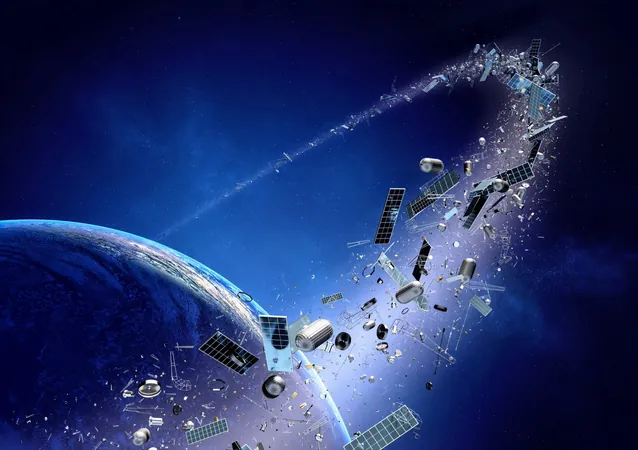
The Alarming Rise of Space Debris: A Threat to Internet Connectivity and Astronaut Safety
2024-12-31
Author: Kai
On October 19, 2023, the US Space Command disclosed a disturbing event: the Intelsat 33e satellite fractured into approximately 20 separate pieces, contributing more debris to an already congested Low Earth Orbit (LEO). This incident has amplified concerns surrounding the mounting peril of space junk, a problem that could have dire ramifications for both internet services and space missions.
What is Low Earth Orbit (LEO)?
Low Earth Orbit, positioned between 100 and 1,200 miles (160 to 2,000 kilometers) above Earth's surface, serves as a primary operational zone for satellites, including communication and earth observation systems. Numerous significant satellites, including the International Space Station (ISS), reside in this area. Because of its proximity, satellites in LEO can achieve quicker data transmission and lower latency, which is essential for modern technologies such as broadband and navigation systems.
Understanding Kessler Syndrome
The concept of Kessler Syndrome, coined in 1978 by NASA scientists Donald Kessler and Burton Cour-Palais, describes a catastrophic scenario where collisions between satellites generate fragments that continue to collide, creating an unmanageable cascade of debris. Should this phenomenon escalate, it could render LEO completely unusable, posing a serious threat to satellite deployments and disrupting essential technological services like GPS and weather forecasting.
Experts, including John L. Crassidis from the University at Buffalo, warn that the risk of debris collisions is escalating: “If the probability of a collision is so great that we can’t launch a satellite, then we’re in trouble.”
The Growing Problem of Space Debris
With over 10,000 active satellites currently orbiting our planet—6,800 of which are part of Elon Musk's Starlink network—space has grown increasingly overcrowded. Each year, numerous fragmentation events, including those caused by deliberate satellite destruction like Russia's military test in 2021, worsen the situation. Bill Therien, CTO at ExoAnalytic Solutions, noted that debris pieces range from small fragments to larger items equivalent to car doors, complicating tracking and removal efforts.
Implications for Space Missions
Astronauts aboard the ISS are frequently at risk due to this debris, having performed multiple evasive maneuvers to avoid collisions. Recent near-misses highlight an unsettling reality: a fragment came disturbingly close—just 2.5 miles—forcing adjustments to trajectory from other spacecraft. If satellites were to collide significantly, it would lead to malfunctions and disruptions of vital services, impacting everything from mobile communication to internet access.
Efforts to Mitigate Space Debris Risks
To combat this burgeoning crisis, organizations like the European Space Agency (ESA) and startups such as ClearSpace are devising innovative strategies like Clearsat-1, which aims to capture and remove defunct satellites from orbit. Technologies like drag sails are also being researched to accelerate the natural descent of debris into the atmosphere.
However, tracking this debris remains a significant hurdle. The ESA has estimated over 40,500 pieces of debris larger than 10 centimeters, with millions of smaller fragments that current radar systems cannot reliably detect. Bob Hall from COMSPOC Corp. indicated that even with advanced sensors, the ability to track smaller debris is limited.
The Call for International Regulations
Experts emphasize the urgency of establishing global cooperation to create binding regulations governing space traffic and debris management. The United Nations' Pact for the Future has set the foundation for addressing these concerns, but effective enforcement remains a significant challenge. Dr. Vishnu Reddy at the University of Arizona insists that developing norms and guidelines within the industry is imperative for protecting our orbital space.
Looking Ahead: Safeguarding Our Orbital Space
As satellite launches continue and the threat of Kessler Syndrome looms ever larger, the need for immediate action to effectively manage and reduce space debris is more critical than ever. The potential consequences could be catastrophic, threatening the future of space exploration and jeopardizing essential services upon which modern society relies.
Thus, it becomes essential for government and industry stakeholders to collaborate on proactive measures—ranging from transformative technological advancements to stringent regulatory frameworks. If left unaddressed, the catastrophic implications of unchecked space debris could reshape our access to space and significantly disrupt our digital lives.
Stay informed on this critical issue and explore the future of space sustainability!

 Brasil (PT)
Brasil (PT)
 Canada (EN)
Canada (EN)
 Chile (ES)
Chile (ES)
 Česko (CS)
Česko (CS)
 대한민국 (KO)
대한민국 (KO)
 España (ES)
España (ES)
 France (FR)
France (FR)
 Hong Kong (EN)
Hong Kong (EN)
 Italia (IT)
Italia (IT)
 日本 (JA)
日本 (JA)
 Magyarország (HU)
Magyarország (HU)
 Norge (NO)
Norge (NO)
 Polska (PL)
Polska (PL)
 Schweiz (DE)
Schweiz (DE)
 Singapore (EN)
Singapore (EN)
 Sverige (SV)
Sverige (SV)
 Suomi (FI)
Suomi (FI)
 Türkiye (TR)
Türkiye (TR)
 الإمارات العربية المتحدة (AR)
الإمارات العربية المتحدة (AR)